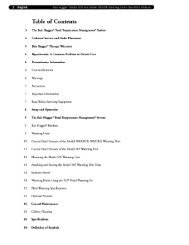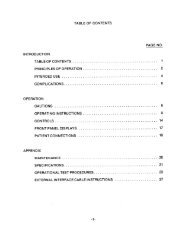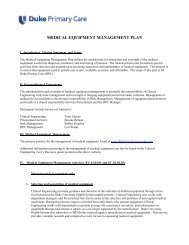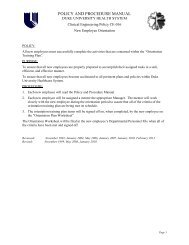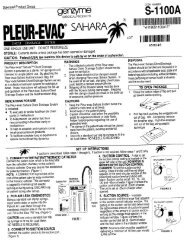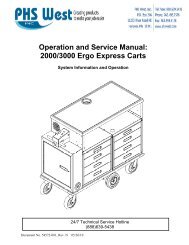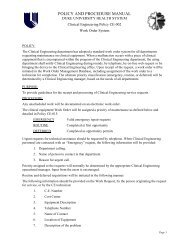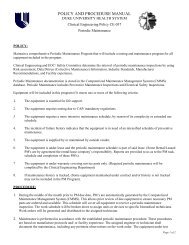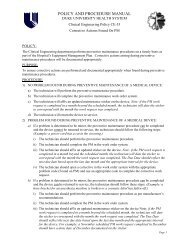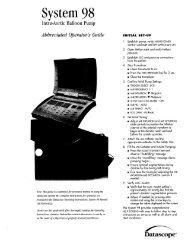Inspection of Patient Related Equipment Procedure - Clinical ...
Inspection of Patient Related Equipment Procedure - Clinical ...
Inspection of Patient Related Equipment Procedure - Clinical ...
Create successful ePaper yourself
Turn your PDF publications into a flip-book with our unique Google optimized e-Paper software.
POLICY AND PROCEDURE MANUAL<br />
DUKE UNIVERSITY HEALTH SYSTEM<br />
<strong>Clinical</strong> Engineering Policy<br />
<strong>Inspection</strong> <strong>of</strong> <strong>Patient</strong> <strong>Related</strong> <strong>Equipment</strong><br />
(Hospital and Non-Hospital Owned)<br />
Compliance with labeling <strong>of</strong> equipment to ensure that equipment has been<br />
evaluated for safety and suitability for intended use by a nationally<br />
recognized (and North Carolina approved ) testing laboratory<br />
Determination <strong>of</strong> inclusion in the <strong>Equipment</strong> Management Program<br />
o Upon satisfactory completion <strong>of</strong> the inspection, a <strong>Clinical</strong> Engineering number<br />
tag (CE #) will be affixed in a visible location on the device. <strong>Equipment</strong> requiring<br />
periodic maintenance will also receive a <strong>Clinical</strong> Engineering maintenance<br />
sticker. <strong>Equipment</strong> exempt from Preventive Maintenance testing will receive a<br />
“PM Exempt” sticker.<br />
o User departments are responsible for reporting to <strong>Clinical</strong> Engineering any<br />
equipment delivered directly to their department.<br />
o Should equipment fail to pass inspection, <strong>Clinical</strong> Engineering will inform the<br />
user department <strong>of</strong> the failure and will not certify the device for use.<br />
o <strong>Clinical</strong> Engineering will work with DUHS Education Services and the end users<br />
to determine the need for in-service education and make appropriate<br />
recommendations for training. It is the user department’s responsibility to<br />
schedule any required training prior to the device being placed in service.<br />
o Note: <strong>Equipment</strong> for the analysis <strong>of</strong> body fluids, cells or tissues must be approved<br />
by the Office <strong>of</strong> the Executive Director, <strong>Clinical</strong> Laboratories, prior to being<br />
placed in service.<br />
Non Duke Owned Medical <strong>Equipment</strong><br />
o Loaner/Evaluation/Physician Owned <strong>Equipment</strong><br />
Over 30 Days – <strong>Equipment</strong> brought into the clinical environment as a<br />
loaner or for clinical evaluation for a period <strong>of</strong> 30 days or more will:<br />
Have a Non-Hospital Owned <strong>Clinical</strong> Engineering number<br />
assigned (NH#) and affixed<br />
Have a Non-Hospital Owned Acceptance document completed<br />
Have a Non-Hospital Owned Acceptance work order completed<br />
and an NH inspection sticker affixed<br />
o Life Support <strong>Equipment</strong> will have a 6 Month Next Due<br />
Date Interval Assigned<br />
o Non-Life Support <strong>Equipment</strong> will have a 12 Month Next<br />
Due Date Interval Assigned<br />
o <strong>Equipment</strong> exempt from Preventive Maintenance testing<br />
will receive a “PM Exempt” sticker.<br />
Under 30 days - <strong>Equipment</strong> brought into the clinical environment for on<br />
loan or for clinical evaluation for a period less than 30 days will:<br />
Have a Non-Hospital Owned Acceptance form completed<br />
Have a Non-Hospital Owned Acceptance work order completed<br />
and an NH inspection sticker affixed.<br />
Note: All service loaners managed by <strong>Clinical</strong> Engineering will<br />
follow procedures under this section<br />
Page 2



